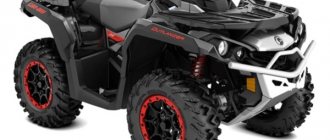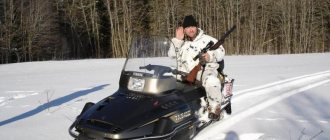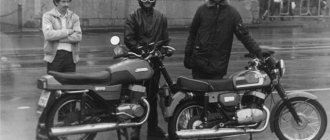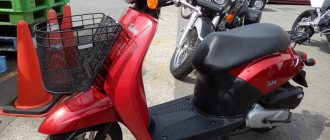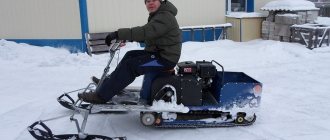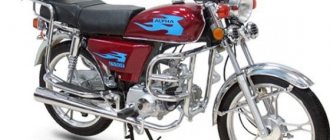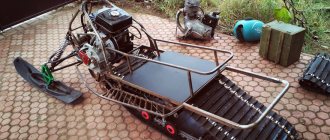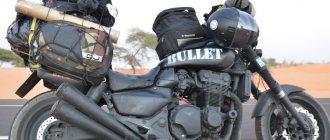There are many legendary motorcycles. The Americans will call you Harley-Davidson, the British - Royal Enfield, the Italians - Moto Guzzy... In the territory of the former post-Soviet space, which includes the countries of Eastern Europe, such a motorcycle is, of course, the Java 350.
Today, when you go to the company’s website, you can find modifications adapted to modern requirements, like the Jawa 350 Replica or Jawa 350 Premier. The legendary brand continues to be popular. But to understand the reasons for this popularity, you should turn to its origins and get to know Java better.
Forward movement
Few people know about this, but the history of a motorcycle with this name began back in 1934. The bike that appeared at that time was equipped with a single-cylinder engine with a power of 12 hp. s., four-speed gearbox, weighed 125 kg. and accelerated to a speed of 100 km/h. He participated in international competitions and won, proving his quality. It was called Jawa 350 SV.
The war made adjustments to the plans of the Czech manufacturer, and the model, which received the Java 350 type 12 index, appeared only in 1948. Due to certain circumstances, it did not last long on the assembly line. The wide Russian consumer had a chance to get acquainted with the next modification - Java 350 354/06, launched into production in 1954. It is this successful car that should be considered the first line in the success story of a popular brand in our country.
Five random articles about motorcycles:
Return conditions and procedure
All purchased goods presented in our store are subject to the manufacturer’s warranty, subject to the Buyer’s compliance with the operating instructions.
When receiving motorcycle spare parts, you need to check the product for visible defects, otherwise complaints about the appearance of the product that are discovered later will not be accepted. When returning or exchanging goods, the Buyer must have with him a receipt of payment confirming the fact of purchase of the goods. The product must retain its presentation, original packaging and consumer properties. The buyer must notify the seller by email or telephone of his intention to exchange or return the product. Auto parts without boxes and without fasteners (bolts or nuts, centering rings) if included, depending on the configuration, are not accepted for return. Guaranteed obligations... Read more >>
Elimination of loose brake pedal on an IZh motorcycle with a sidecar
Reliable fastening On IZh motorcycles with a sidecar equipped with a brake, the pedal soon becomes loose.
In this case, the order of operation of the brakes of the motorcycle and the trailer is disrupted, which is why the crew skids to the side when braking, especially sharply. In addition, the adjustment of the brake light switch changes. To eliminate this drawback, I turned out axle 9 (see Fig. “b”) and attached the brake pedal to it, drilling a hole in the support plate 2 of the frame to 12 mm. Since then this unit has been working properly. Brake pedal mounting unit: a - factory version; b - revised version; 1 — brake pedal; 2 — frame support plate; 3 — M10 bolt; 4 - bushing; 5 - spring washer; 6 — nut M10; 7 — washer; 8 — M12 nut; 9 - axis. This modification will not hurt those who travel without a stroller. Gorky city GRACHEV 1987N09P33 Read more >>
A journey of half a century. IZH-7, IZH-D, IZH-9, IZH-350, IZH-49, IZH-56, IZH-Planet-4, IZH-Jupiter-4
IZH-7, IZH-D, IZH-9, IZH-350, IZH-49, IZH-56, IZH-Planet, IZH-Jupiter On the outskirts of Izhevsk there is a monument - motorcyclists on rearing cars.
It symbolizes the successes of city workers in the production of motorcycles and in the development of motorsports. Half a century ago, in accordance with the decision of the People's Commissariat of Heavy Industry, motorcycle production was organized here in Izhevsk on the basis of the experimental workshops of Izhstalzavod. Even earlier, in 1928, in these workshops, a group of enthusiasts under the leadership of engineer P.V. Mozharov designed and built prototypes of machines. However, due to the lack of production capabilities, it was not possible to launch serial production of motorcycles. Izhevsk residents began producing them in 1933. Between the two models you see in the pictures, there is a journey of half a century. We started with the IZH-7 motorcycle, which differed only in details from the simple L-300 machine with a two-stroke engine, mastered by that time in Leningrad and two-cylinder “Jupiters” have gearboxes of the same design, but differing in the shift mechanism and gear ratios. On currently produced models IZH-P3, IZH-PS, IZH-Yu4 use standardized gears (see table), which can also be installed on previous models - IZH-49. IZH-56, IZH-P, IZH-P2, but only together with the input shaft, clutch drums and shift forks from IZH-P3. During operation, faults in the gearbox most often arise from overloads, rough, forceful gear shifting, untimely oil changes . There are often cases of damage to parts after home repairs of the box, when mistakes are made during its assembly and adjustment. Let's look at the most common malfunctions. Second and third gears do not engage (first and fourth gears do). On “planets” this defect appears due to the loosening of the screws securing the stop mechanism of the re... Read more >>
Motorcycle IZH Jupiter 5K 01. Jupiter is the fifth and last?
Jupiter is the fifth and last? By the beginning of winter, when I started writing this report, the editorial “Jupiter-5K-01” began to spin sixteen thousand kilometers. Such mileage does not yet allow us to give comprehensive information about the advantages and disadvantages of the model.
Nevertheless, there are enough impressions; experts say that to determine the quality of a dish it is not necessary to eat it entirely. We will follow this principle. To begin with, despite the radical red color, I did not notice any revolutionary changes in Jupiter-5. Essentially, this is the same, well-known IZH-Jupiter with a more modern appearance. Of course, there is movement for the better, but only with the goal of “holding out” the motorcycle, at a time when a qualitative leap is needed. The product was forged purely for domestic consumption, it is clear that Izhmash does not yet plan to compete with such thoroughbred horses as, for example, BMW, Honda or Yamaha... Read more >>
login registration forgot your password?
Motorcycle goods store About the store Terms and return procedure
Decent characteristics of Java 350
The bike, unlike its predecessors, received a two-stroke two-cylinder engine with a volume of 350 cc. cm, air-cooled. Power increased to 16 hp. s., and in later versions, after installing a new carburetor, up to 18 liters. With.
By the way, the Java 350 carburetor was subsequently modified several times. The maximum speed was 115 km/h (with a direct landing of the motorcyclist). The drum brakes worked reliably, and the front and rear forks with telescopic shock absorbers ensured comfortable movement on paved roads.
This became especially noticeable in 1958, when cone-type shock absorbers were replaced with piston ones. The voltage of the battery and generator used to operate the electrical equipment of the Java 350 motorcycle is 6 volts. Weight – 139 kg. Consumption, for that time, was very moderate - 3.6 liters.
The appearance of the model not only corresponded to the trends of the time, but was progressive and well thought out. It was the modification 354/06 that Viktor Tsoi was seated on by the author of the monument to the famous rock musician, Alexey Blagovestnov. As an element of a monumental composition, old Java looks very harmonious.
Features of electrical equipment
In many respects, the components and assemblies of the Czech motorcycle were similar to domestic products, but at the same time they differed:
- high quality;
- amazing wear resistance;
- maintainability and long service life.
Advice: when servicing a motorcycle with their own hands, owners often face a shortage of original spare parts. If you need to use non-original electrical appliances, you should carefully select their technical parameters.
In those years, Java motorcycles were in short supply, so they were often sold second-hand. And at the same time, the price remained quite high. New owners could immediately get behind the wheel and operate the equipment without any restrictions, because:
- wiring to Java did not require maintenance;
- the engine had a significant service life;
- shock absorbers and suspension had a fairly high safety margin;
- consumables were required no more often than provided for by the technical regulations.
Repair instructions for Java motorcycles officially supplied to the USSR
However, the manufacturer constantly modernized its motorcycle models, and each time made changes to components and assemblies. In particular, in different years the following were supplied to the territory of the USSR:
- model 559-07 was produced since 1969 under the name “JAWA 250” and was a variant with a 250 cc engine producing 12 hp. with 6V equipment;
- model 634 (01-04) was produced from 1973 under the name “JAWA 350” and represented a variant with an increase to 350 cc. cm 16 hp motor, designed to work with 6V equipment;
- model 634 (01-08) was produced since 1977 under the name “JAWA 350”, but already with 12-volt equipment and on 16-inch wheels;
- Model 638 has been produced since 1986 under the name "JAWA 350". It had only visual differences in the shape of the frame and was equipped with 18-inch wheels (see wiring diagram for Java 638);
- Model 640 was the last modification that was officially supplied to our country. It was also designed to operate 12-volt equipment and had differences in design and suspension.
Original wiring diagram for Java 12V model 638
Equipment 6W
For the first 8 years of deliveries from Czechoslovakia, JAWA motorcycles were equipped with equipment designed for a current of 6V.
Original color diagram of electrical equipment Java model 634
There are differences in the above diagram due to modification. In particular, the JAWA 634.8.00 model does not have:
- direction indicator warning lamp;
- neutral control lamp in the gearbox;
- breaker capacitors.
Subsequent motorcycles had these electrical parts installed at the factory. And domestic craftsmen independently equipped their “iron horses” using a new scheme.
For reference: the magazine “Behind the Wheel” provided invaluable assistance to motorcyclists, publishing color diagrams of electrical equipment taking into account the amendments officially received from the Czech manufacturer.
Differences in voltage were not an obstacle for owners, who often independently converted the motorcycle’s power supply from 6V to 12V. This required:
- replace the generator with a new six-pole one with a self-excitation system of electric current, which made it possible to operate the motorcycle with a completely discharged battery;
- replace incandescent lamps with more powerful ones;
- install contactless electronic ignition;
- replace high voltage wires.
Equipment 12W
Later, the manufacturer recognized the promise of 12-volt equipment and began to equip its products with it. Thereby:
- electronic ignition appeared on motorcycles;
- changing the generator circuit made it possible to operate the vehicle without a battery (during the daytime);
- The luminous flux of the headlights has increased and the brightness of the side lights has increased.
Original photo of the Model 640 wiring diagram in Czech
Features of 12 volt equipment include a bipolar turn relay, which has not previously been found on motorcycles. Its operation scheme is based on the principle of the difference in the current consumption of the control lamp (6W) and the direction indicator lamps (21W):
- when turning on the right turn, “+” from the generator or battery enters the right turn circuit, passing through the terminals of the bipolar relay;
For reference: the role of a conductor in a relay is played by a thin nichrome thread, the peculiarity of which is the ability to stretch when heated and recover when cooled, which leads to a cyclical process of interrupting the circuit.
- in this case, current is supplied to the right front and rear right turn signal lamps;
- The indicator lamp is directly connected with one contact to the right turn circuit, and the other to the left turn circuit. When the right turn is turned on, “+” is supplied to the control lamp, and “-” appears in the left circuit of the control lamp for the other contact, coming through the filament of the left lamp of the turn circuit (see also the Java 350 wiring diagram).
For reference: the control lamp lights up simultaneously when the lamp of the right or left circuit is turned on, since its switching current is almost 10 times less than that of a pair of turn signal lamps.
There are no boundaries for perfection
In 1964, after modernization, the Java 350 received a new designation - K?va?ka Automatic typ 360/01. The main characteristics, such as power and maximum speed, remained at the same level.
But changing gears has become much more convenient due to the installation of a semi-automatic clutch. The design of the optical elements has been changed. The shape of the wings was adjusted. The popularity of the Java 350 grew and, despite the fairly high cost of the equipment, queues lined up in stores for it.
This model can already be safely called a cult model. Tuning it is not the best solution. Many motorcycle history buffs want to add Java 350 354/06 and 360/01 motorcycles to their collection of rarities.
MY MOTORCYCLE
Who doesn't recognize this beauty?
Yes, this is the famous Java-638.0 - as soon as this new example of the line of legendary motorcycles appeared in the vastness of the Soviet motorcycle movement, all teenagers and not only them began to dream about it. For a very long time she traveled the vast expanses of our roads, and even in our time there are entire clubs of “yavists” (there was a neighbor - he got tired of peeping near the windows for days) that do not betray the legendary motorcycle. A lot of people started with "Jav". Today we’ll talk about the Java 638. Let’s also remember all the qualities and disadvantages of this motorcycle. The motorcycle is ideal for driving around the city and short distances - it is easy to control, does not overheat in traffic jams and at traffic lights, has a good design, and most importantly - 12-volt electrical equipment. What the “Yavists” (and not only them) dreamed of for so long—a bright light—was finally realized at the “eight”. Consumers operate from the battery only when the motor is silent. Once you start it, everything is taken over by the most powerful (210 W) generator. The motorcycle is very unpretentious, does not require close attention, maintenance is easy and simple. But the motorcycle is practically not protected from thieves. The steering wheel lock has never even been satisfactory (not that good), and the so-called “ignition lock” can be unlocked with any object such as a nail or a twig of a suitable size. The old Java cars had very good locks with a number key. It's a pity that they are gone. So the owners of “Jav” and “ChZ” have to go to all sorts of tricks in coming up with all sorts of “secrets” and other anti-theft devices, right down to chains with locks and super guards.
If you want to travel on a Java, then a problem will arise. Well, it’s not suitable for serious travel, except perhaps nearby and on normal roads:
The wide saddle and forward-leaning riding position, so comfortable in the city, are very tiring here on the highway. The “old ladies” with their low and narrow handlebars were even more comfortable. And the 638 has a high center of gravity, which is why the motorcycle holds the road worse on mud and ice and has difficulty holding on after holes and potholes, of which there are countless on our “almost smooth” roads.
The large supply of tools in the seat box is a plus. But it’s very difficult to get to the coveted keys on a long journey - you need to raise the saddle, but you’ve packed all sorts of stuff for the trip - that’s the problem. By the way, the elongated saddle trim forces the top parcel shelf to be raised very high, which does not change stability and controllability for the better.
Let's now look at the components and assemblies. Unfortunately, few kind words can be said about the engine, which, although it contains successful design discoveries, has serious shortcomings. (We’ll talk about them later in the article, when reviewing motorcycle problems). The engine is relatively simple, a traditional two-cylinder two-stroke with loop scavenging. The circuit is simple and despite problems starting in cold weather (due to condensation of the mixture) it works fine. But in terms of execution... Since there is only one carburetor installed on the engine, synchronous operation of the cylinders can be achieved by selecting the ignition timing separately for each cylinder.
The design of the starting enrichment device is quite successful - the engine starts with half a turn. It is almost impossible to “flood” the engine. The only trouble is difficult starting in cold weather. In vain, apparently, the float quencher was removed from the design. Another thing is that the carburetor is attached to the flange through a rubber coupling, which greatly reduces the transmission of vibrations from the engine. Transmission. The design of the clutch is simple, assembly and disassembly is easy. But sometimes it jams for unknown reasons. How to find and eliminate them will be discussed in the article below, when we consider Java diseases. As for the posterior chain, its service life is short. For some reason, during intense driving it is not enough for a long time (I’m generally silent about the crazy one). Although it is in a sealed casing. Electrical equipment
The generator is powerful and reliable. But the system for monitoring its operation is clearly unsuccessful - in the event of a phase failure, the control light will not light up, and the generator will burn out. It would be better if an ammeter was installed at the factory at the break in the wire from the battery to the ignition switch, rather than providing this opportunity to motorcyclists. If the electronic voltage regulator suddenly fails, which is quite possible, then it can be replaced with almost any automobile regulator, and those who understand radio engineering can repair them on their own. In general, electrical equipment copes with the functions assigned to it. The rear light is well made: there are two “marker” bulbs, so the failure of one does not deprive the motorcycle of information on the road. By the way, it is advisable to make a “mass” switch on the motorcycle - this is useful for the battery when the motorcycle is “resting”. The frame has greater strength, rigidity and weight compared to IZh or ChZ. The front fork combines soft operation and reliable damping of shocks and shocks. It also has high torsional rigidity and holds the road well, but when the motorcycle accelerates over a hundred, it breaks above the road due to its low weight and the center of gravity is slightly moved back. The rear shock absorbers showed their best side - even if the motorcycle is used in difficult conditions, they withstand them quite well and will not leak immediately (it will happen sooner or later, but in the early stages of operation they hold up quite well). Now let's talk about the second side of the coin - the small sores of this motorcycle.
In order to evaluate the 638, let’s remember the shortcomings of the previous one: weak six-volt electrical equipment, chronic undercharging of the battery, low-capacity tool boxes and ever-leaking front fork seals. All these “bottlenecks” have been successfully “embroidered” in the new model with the index “638”. The motorcycle has a rational and finished appearance. The new saddle, which is 50mm wider and 70mm longer, is much more comfortable than the previous one.
Let's return to the power unit: In general, many motorcyclists considered the best engine the ChZ-350 model "472-6", which combines the reliability of the "634" and a 12-volt generator. The “638” engine is well packaged. Its lightweight aluminum cylinders with well-developed fins are well cooled. I am especially pleased with the new connection between the cylinder and the muffler pipe: it is simpler and more reliable than all previous ones. The carburetor is now attached not to the crankcase, but to the cylinders through an adapter. The instructions, unfortunately, do not describe the sequence of installation of these parts, and beginners make mistakes during assembly, first tightening the cylinders, and then the carburetor with the adapter. The cylinder heads should be lightly tightened with nuts, then the adapter with the carburetor should be installed and tightened. The cylinder head nuts are tightened last. Failure to comply with this order leads to the formation of gaps between the cylinders and the carburetor adapter. The carburetor is a bit fiddly and doesn't suit the relatively simple bike. There are many complaints about his work. The jets are so small that they easily become clogged with particles that are difficult to see. But the main drawback is the starting qualities. It has been noted more than once that to start the engine in cold weather it was necessary to pour gasoline through the spark plug holes. But increasingly, engines do not start even in warm weather. Cleaning and adjustments don't help. The advice to clamp the ventilation holes during startup is absolutely useless. And this is on new engines! What can we say about worn-out ones, which require a richer fuel mixture when starting? There is an option to try installing a carburetor from the 634 on the 638th engine. To do this, the front part of the Yikov-2926 carburetor needs to be machined to a cylindrical configuration. Then make an adapter sleeve with an internal diameter along the machined part and with an external diameter according to the dimensions of the front part of the Yikov-2838 carburetor. We secure the bushing against turning with an MZ screw with a countersunk head. The starting quality of the engine should immediately improve. It starts easily both at zero degrees and in 30-degree heat.
The gas tank, with the same volume, looks larger than before. Its stopper has become one of the advantages of the new model, both in appearance and for its intended purpose - locking the neck. But the factory probably used a thinner metal sheet to make it, because dents appear on it much faster and easier. The wheels, sprockets and chain are the same as the 634 model and are just as reliable. The brakes haven't changed much, although the bike's speed and power have increased. The rear brake cover paired with a reaction lever is one of the weak points of all “java”.
It happens that during sharp braking the cover turns out the reaction lever. And then - a break in the brake cable, wheel locking, skidding and often a fall. Such an emergency situation occurs not only due to the fault of the motorcyclist who did not properly tighten the rear wheel axle nut. It's all about the design. Some axles simply don't have enough threads. It would seem that the nut is fully tightened, but there is a gap between the brake cover and the reaction arm. I advise owners to be careful when assembling the rear wheel and, if such a malfunction is detected, install a 5 mm thick washer on the axle, preferably on the right side. The steering column lock is still not secure. A slight jerk of the steering wheel to the left is enough - and the lock is broken, the motorcycle becomes easy prey for a thief. Clutch. This is a new unit, and it also causes a lot of complaints from owners. The main defect is intensive wear of the drive drum teeth. It is noteworthy that this is not observed on the crankshaft sprocket, although they work in pairs. This is probably due to different degrees of hardening of the metal or its choice. Jerking and shaking when starting off are also found on the 638 Java. This defect turned out to be especially insidious, since outwardly all the clutch parts seem to be in good order, but adjusting the machine and tightening the fasteners does not give any results. A thorough search for the defect will lead to the clutch basket cover, where the lower holes are of a smaller diameter, which is why the clutch periodically jams. If you notice this defect, increase the holes to the nominal size, this will relieve the unpleasant “fever”. There is also such a nuisance as the destruction of the middle bearing of the crankshaft. The reason is in the crankcase and its middle partition. It is difficult to say for what reason, but some have encountered the fact that the lubrication hole in the crankcase scavenge channel did not have access to the cavity of the middle partition of the crankshaft, as a result of which one of the middle bearings was left without lubrication. Anyone who had previous JAV models was accustomed to the precise rhythm of their cylinders. Therefore, the lack of synchronization of the exhaust sound on the 638 model is acutely perceived. Unfortunately, this is inherent in the design of the engine and carburetor. But to an even greater extent it depends on the design of the right half of the engine. When installing a new bearing 3205 and its seal, for the sake of unification of parts, the reliability of sealing the crank chamber was reduced. Imperfection of the crankcase seals on Java cars is possible (this is an option) and has led to a shortage on the right pistons. It can be assumed that the left piston, albeit slightly, sucks oil from the gearbox and is thereby additionally lubricated. The right one can only suck in air. Hence the unequal life of the pistons, unstable idling, “smeared”, unclear exhaust sound, especially on engines with high mileage. But again, this does not happen on all models, depending on your luck. JAVA's electrical equipment works without any problems, but not everyone likes the electronic relay-regulator: the mechanical one is much more reliable and is not afraid of an accidental short circuit. The generator brush assembly has also become in short supply. Even on new parts, the body is covered with cracks, and the material itself is not heat-resistant. Frequent failure to charge the battery is explained by the fact that the carbon brushes become very hot from the commutator and melt the lower part of the brush holder, which leads to their jamming.
On this note, we can, in principle, end the story about the Java 638 model. It has many positive qualities, but there are also disadvantages. Although they did not prevent many generations from loving and riding this motorcycle. Nothing is perfect.
I hope you liked the article. We are waiting for comments…….
Rare and beautiful
One should not think that Czech motorcycles were sold exclusively in Eastern Europe. Jawa products were also supplied to the West. In 1969, an export modification of the Jawa 350 Californian IV typ 362, 363 was developed, which featured an original design. But relatively few such machines were produced.
A little later, in 1970, they released a modification of the Jawa 350 U? typ 633/1 Bizon, the characteristic features of which were a specifically shaped fuel tank and an abundance of compartments for storing tools and luggage. Today such a bike is a rarity, and if you happen to have a similar model at your disposal, then, unlike some Izh Planet-5, its tuning will be simply madness.
Named "Java" - the history of the legendary motorcycle
In 1938, at an exhibition in Prague, the organizers invited visitors to take a test ride. This turned out to be such a successful advertising move that the demand for motorcycles soared in the blink of an eye, and the factory decided to produce a limited series of 50 motorcycles with redundant controls for training novice motorcyclists. This further spurred the demand for the baby Villiers; journalists became interested in it and spread the news about the outlandish “training” design in every way possible at that time, at the same time advertising the motorcycle itself as a production one.
Villiers was produced until the Second World War, several hundred more motorcycles were produced in 1946, after the end of the Nazi occupation of Czechoslovakia, and in total it sold 27,535 copies. The 175-cc engine turned out to be such a successful development that it practically ousted all other players from the field: if in the early thirties the import of motorcycle equipment into Czechoslovakia was 90%, then by the end of the decade everything was turned upside down - the vast majority of new motorcycles were domestic, instead of foreign cars accounted for less than ten percent of the market. Together with Villiers, Janecek's plant produced several more models in the thirties, but they were not so popular.
New big brother
By 1934, the factory was preparing a new model with a 350 cc engine, which was supposed to stand between the bulky “500”, which had been discontinued by that time, and the small Villiers. The prototype presented at the 1934 motor show was in keeping with the fashion and progress of those years. Signature features, such as a double frame in the shape of triangles, a teardrop-shaped fuel tank and, of course, red color, have already become a good tradition of the Jawa brand.
Innovations included an electric starter-generator and a gearbox, which was not connected, as before, to the engine in a single unit, but was moved back to the rear wheel axis. Torque was transmitted to it from the engine via a shaft - this arrangement is called transaxle.
But the revolutionary nature of the model also determined the other side of the coin - the high price, and Janecek already knew what the demand for expensive motorcycles was from the example of the Jawa 500 cc. Therefore, the “three hundred and fiftieth” series went into production in a much simpler design. The four-speed gearbox was “returned to its place”, and it could be controlled using a tricky lever either by hand or by foot, and the rear drive wheel was driven by a regular chain.
Next step
But time took its toll, and the management of the Czech company decided to make serious changes. In 1973, motorcycle enthusiasts had the opportunity to get acquainted with the Java-350 type 634. On the new bike, the frame design was changed and the engine design was seriously redesigned, increasing power to 23 hp. With.
The maximum speed indicated in the technical description, despite the weight gain of up to 160 kg, increased to 125 km/h. True, fuel consumption has also increased, amounting to 4.5 liters of gasoline per hundred kilometers at a speed of 80 km/h. The advantages of the model are:
- Ease of control and stability at high speeds, which, combined with a comfortable suspension and comfortable seating, had a beneficial effect on the fatigue of the motorcyclist. It was possible to cover a considerable distance behind the wheel without any problems.
- Operational reliability and solid design life.
The main disadvantage was considered to be the high price.
Close relationship
Almost simultaneously with this model, the CZ 350 motorcycle appeared, differing in the design of the frame, the shape of the fuel tank, and suspension settings. If the Java 350 with a sidecar was normal, then the Chezet 350 was sold only in a single version. The model produced at the Cesk Zbrojovka enterprises was considered to be more sporty, although it had characteristics similar to the Java 350.
New standards
In 1984, a new modification, type 638, went into production. Changes affected the power unit. The profile and flow area of the intake and exhaust channels were changed, improving the purging of the cylinders. The Java 350 engine received an aluminum cylinder block and lightweight pistons. Power increased to 27 hp. s., and fuel consumption decreased to 4.2 liters. The maximum speed remained unchanged.
An important innovation was the installation of electrical equipment operating at a voltage of 12 volts. The new 12-volt system has significantly reduced the weight of the generator and other electrical components. The measures taken led to a weight reduction to 149 kg. It is based on this model that the Jawa 350 Replica is being produced today.
During production, the design on these Javascripts was adjusted several times. The shape and finish of the fuel tank changed. A small fairing was installed on the steering wheel. No matter what changes the Java 350 underwent, the technical characteristics were at a high level.
Before the crisis
A further development of the model was the Jawa 350 typ 639, launched into production in 1990 and a year later giving way to the Jawa 350 640 modification on the production line. The features of this machine include the front disc brake that appeared in later versions.
There were no major changes in technical parameters. This was the last modification, the production of which was launched before the collapse of the USSR. As for the Java 350 sport, contrary to popular belief, such an option was never produced. Only motorcycles with an engine capacity of 250 cc were awarded the sport prefix. cm.
Java today
At the beginning of the 90s of the 20th century, difficult times came for the Czech manufacturer of motorcycle equipment, as for many enterprises in the post-Soviet space. And yet the company remained afloat. Last but not least, thanks to the large number of Java 350 fans.
The company continues not only to produce motorcycles, but also to supply them to Russia. Some of the models presented in the catalog are direct heirs to the former glory of the brand:
- Jawa 350 Premier is a road bike that can be equipped with an electric starter as an option. The appearance of the car has been changed in accordance with modern ideas about design, but an experienced eye will certainly recognize under the newfangled makeup the Java 350 640 familiar to Russian consumers. Such is the Premier!
- Jawa 350 Lux, like Jawa 350 Premier, is also a reincarnation of the model released in 1991. The modification received an original-shaped fuel tank, a digital instrument panel and a plastic case attached to the trunk.
- Jawa 350 Replica. There is no need to say anything here. The modification was not only created on the units of classic Java 350 motorcycles, but also stylized as models from the heyday of the company.
The popularity of the replicas produced by the company is quite high. The main thing for these models is not speed, but reliability, comfort and recognition. Seeing such equipment in traffic, many sometimes believe that it is tuning.
Conversion of electrical equipment in Java
Our magazine has repeatedly discussed the shortcomings of the power supply of the YAVA-634 motorcycle, produced before 1985.
At low crankshaft speeds (up to 1800 per minute), the 6-volt generator does not produce energy, and all consumers at this time are powered by the battery. If the lights and headlights are on, the battery is quickly discharged, which, with repeated cycles, leads to its failure. The only measure to avoid this trouble is to maintain medium speed even on bad roads or stops at intersections. It is clear that this causes great inconvenience, especially for residents of rural areas. The currently produced JAVE model “638” uses a 12-volt electrical system (its description and diagram are given in No. 6, 1987), where a more advanced and powerful generator begins to operate already at 1000 rpm.
It is clear that many owners of the old model want to switch to new electrical equipment, but they encounter an obstacle: the main device - the generator - has different connecting and overall dimensions.
A student from the Ural city of Kurgan D. KUZNETSOV overcame this difficulty and successfully converted his car.
Through the Moscow special base of Rosposyltorg, the address of which is indicated in the instructions attached to the motorcycle, I received a generator (12 V, 210 W), a battery (12 V, 5 Ah) “Trepcha”. The choice is explained by the fact that the domestic battery 6 MTS-9 cannot be placed in the cramped underseat compartment without modification. I also purchased a rectifier, two ignition coils, and a turn signal relay. Since the “native” (model “638”) voltage regulator and warning lamp relay could not be found, I bought a PP330 relay from the Ural motorcycle, taking into account that the difference in generator power between JAVA and Ural is small - 210 and 200 W, respectively .
The essence of the change is as follows.
Mechanical part . We make transition flanges (Fig. 1) and cones (Fig. 2) from steel of any grade. When marking the flange, we use the generator stator as a template, and the cone as the rotor. In addition, it is necessary, having assembled the stator with the flange, to cut a small recess into them with a round file for the screw securing the right crankcase cover. We install the adapter flange instead of the old 6-volt generator in the crankcase bore and fasten it with two M6 X 30 screws. Then we put the adapter cone and the generator rotor on the crankshaft journal. We fasten the stator with four M6 X 10 screws to the adapter flange. To avoid damaging the brushes when installing new parts, it is better to temporarily remove them from the generator.
Rice. 1. Adapter flange.
Rice. 2. Transition cone .
Since the new generator is larger in size, it is necessary to process (preferably on a vertical milling machine, but also manually) the right crankcase cover, removing part of the partition. To avoid damaging the cover on the machine, first insert a spacer, as shown in Fig. 3. In addition, from a suitable material - plastic, cardboard, etc., we make a spacer under the cover with a thickness of 4 mm, using the right crankcase cover as a template.
Rice. 3. Crankcase cover : 1 - spacer; 2 - spacer; 3 - partition.
To protect the generator from dust and dirt, we glue in a rubber partition. We use epoxy glue for it and the gasket.
It is also necessary to prevent the brake pedal from touching the now “expanded” engine - by removing the pedal and the brake shaft, shorten it by 4 mm or make a new spacer sleeve 5 (Fig. 4) and grind sleeve 7 4 mm long. After assembly according to the figure, the pedal will be shifted to the right.
Rice. 4. Foot brake drive : 1 - brake lever; 2 - adjusting screw; 3 — felt ring; 4 — motorcycle frame; 5 — spacer sleeve; 6 — brake pedal shaft; 7 — additional spacer sleeve; 8 — brake pedal.
Electrical part . To redo the electrical wiring, you need to stock up on 6.3 mm wide plugs and colored automotive electrical wiring. If we use devices from the “638” model, we connect them according to the “native” circuit published in “Behind the Wheel” (1987, No. 6). When a PP330 relay-regulator is used (from Ural or another 12-volt one with the same terminals), we carry out the wiring as indicated in Fig. 5. In any case, you will have to change the connection diagram for the neutral control lamps and the operation of the generator. To do this, you need to remove the jumper connecting these lamps.
Rice. 5. Power supply system diagram : 1 - ignition coils; 2 — brake light switch; 3 - generator; 4 - rectifier; 5 - battery; 6 - fuse; 7 - relay regulator; 8 — neutral gear lamp switch; 9 — neutral gear lamp; 10 - indicator lamp for generator operation.
Further. We connect the blue wire coming from pin “54” of the ignition switch to the neutral control lamp. We connect the generator control lamp with an additional wire to the housing. To ensure a reliable “ground” for the tachometer and speedometer backlight lamps, it is necessary to lay another “negative” wire, as was done for the JAVA model “638” (see the above-mentioned diagram in the magazine). We connect the additional wire from the brake light switch to the “VZ” contact of the PP330 relay, the drive from the DF contact of the generator excitation winding to the “W” contact. We connect the blue wire from the generator warning lamp to the “LC” contact. Contact “86” of the generator is connected to contact “~” on the relay. It is advisable to immediately install the ground switch on the negative wire running from the battery to the motorcycle frame.
As for the headlight, to connect a new lamp you need to replace the narrow plugs with wide ones from any motorcycle or modern car headlight that has a 45/40 W lamp. You can use old wires from the ignition coils, bending their plug tips just a little. I installed the PP330 relay-regulator and rectifier in the seat compartment.
Replacing 6-volt to 12-volt ignition coils, light bulbs, turn signal relays and horn does not cause any difficulties.
In a similar way, I converted my model 634-7-00 nuclear power plant in 1985, and then two more cars were converted according to my drawings.
1988N07P14-15
Copy or original?
However, both Jawa 350 Premier and Jawa 350 Replica are unlikely to satisfy a true connoisseur of the legendary brand’s products. Why do they need copies when they can buy the original? After all, in our country you can still find and restore classic Java motorcycles to their original condition. And tuning is inappropriate here!
If you still want to remake some motorcycle equipment to your liking, then on our website you can find out about tuning the Voskhod-3M, a Soviet motorcycle that was mass-produced at the Degtyarev plant in the city of Kovrov.
Previous entry Composition and parameters of electrical equipment IZ Jupiter 5
Next entry Motorcycle Java 350 638: review, technical specifications
Characteristics
If you compare the Java-350-638 with modern bikes, then in terms of technical characteristics it is significantly inferior, but over the years it has practically not lost its popularity .
And its characteristics are as follows:
| Technical characteristics of Jawa-350-638 | ||
| Parameter | Unit change | Index |
| Length | mm | 2110 |
| Width | mm | 750 |
| Height | mm | 1070 |
| Seat height | mm | 810 |
| Clearance | mm | 130 |
| Wheelbase | mm | 1335 |
| Dry mass | kg | 156 |
| Engine | Type | 2-cylinder, 2-stroke, |
| Working volume | cube cm. | 350 |
| Power | hp | 26 |
| Transmission | type | mech., 4-speed, |
| Drive unit | type | Chain |
| Volume of the tank | l | 17 |
| Maximum speed | km/h | 130 |
